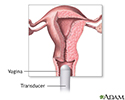Transvaginal ultrasound
Endovaginal ultrasound; Ultrasound - transvaginal; Fibroids - transvaginal ultrasound; Vaginal bleeding - transvaginal ultrasound; Uterine bleeding - transvaginal ultrasound; Menstrual bleeding - transvaginal ultrasound; Infertility - transvaginal ultrasound; Ovarian - transvaginal ultrasound; Abscess - transvaginal ultrasound
Transvaginal ultrasound is a test used to look at a woman's uterus, ovaries, tubes, cervix and pelvic area.
Transvaginal means across or through the vagina. The ultrasound probe will be placed inside the vagina during the test.
How the Test is Performed
You will lie down on your back on a table with your knees bent. Your feet may be held in stirrups.
The ultrasound technician or doctor will introduce a probe into the vagina. It may be mildly uncomfortable, but will not hurt. The probe is covered with a condom and a gel.
- The probe transmits sound waves and records the reflections of those waves off body structures. The ultrasound machine creates an image of the body part.
- The image is displayed on the ultrasound machine. In many offices, the patient can see the image also.
- The provider will gently move the probe around the area to see the pelvic organs.
In some cases, a special transvaginal ultrasound method called saline infusion sonography (SIS) may be needed to more clearly view the uterus.
How to Prepare for the Test
You will be asked to undress, usually from the waist down. A transvaginal ultrasound is done with your bladder empty or partly filled.
How the Test will Feel
In most cases, there is no pain. Some women may have mild discomfort from the pressure of the probe. Only a small part of the probe is placed into the vagina.
Why the Test is Performed
Transvaginal ultrasound may be done for the following problems:
- Abnormal findings on a physical exam, such as cysts, fibroid tumors, or other growths
- Abnormal vaginal bleeding and menstrual problems
- Certain types of infertility
- Ectopic pregnancy
- Pelvic pain
This ultrasound is also used during pregnancy.
Normal Results
The pelvic structures or fetus is normal.
What Abnormal Results Mean
An abnormal result may be due to many conditions. Some problems that may be seen include:
- Birth defects
- Cancers of the uterus, ovaries, vagina, and other pelvic structures
- Infection, including pelvic inflammatory disease
- Benign growths in or around the uterus and ovaries (such as cysts or fibroids)
- Endometriosis
- Pregnancy outside of the uterus (ectopic pregnancy)
- Twisting of the ovaries
Risks
There are no known harmful effects of transvaginal ultrasound on humans.
Unlike traditional x-rays, there is no radiation exposure with this test.
References
Brown D, Levine D. The uterus. In: Rumack CM, Levine D, eds. Diagnostic Ultrasound. 5th ed. Philadelphia, PA: Elsevier; 2018:chap 15.
Dolan MS, Hill CC, Valea FA. Benign gynecologic lesions: vulva, vagina, cervix, uterus, oviduct, ovary, ultrasound imaging of pelvic structures. In: Gershenson DM, Lentz GM, Valea FA, Lobo RA, eds. Comprehensive Gynecology. 8th ed. Philadelphia, PA: Elsevier; 2022:chap 18.
Hur HC, Lobo RA. Ectopic pregnancy: etiology, pathology, diagnosis, management, fertility prognosis. In: Gershenson DM, Lentz GM, Valea FA, Lobo RA, eds. Comprehensive Gynecology. 8th ed. Philadelphia, PA: Elsevier; 2022:chap 17.
Kelly CM. Ectopic pregnancy. In: Kellerman RD, Rakel DP, eds. Conn's Current Therapy 2022. Philadelphia, PA: Elsevier; 2022:1240-1243.
Ultrasound in pregnancy - illustration
Ultrasound in pregnancy
illustration
Female reproductive anatomy - illustration
Female reproductive anatomy
illustration
Uterus - illustration
Uterus
illustration
Transvaginal ultrasound - illustration
Transvaginal ultrasound
illustration
Review Date: 4/19/2022
Reviewed By: John D. Jacobson, MD, Department of Obstetrics and Gynecology, Loma Linda University School of Medicine, Loma Linda, CA. Also reviewed by David C. Dugdale, MD, Medical Director, Brenda Conaway, Editorial Director, and the A.D.A.M. Editorial team.








